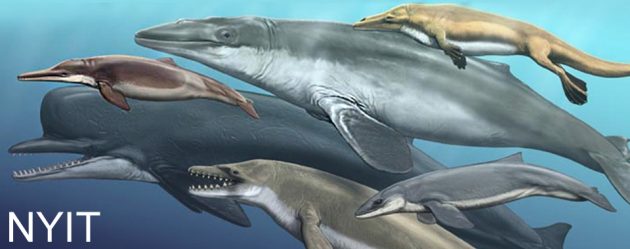The origins of marine mammals

Although all marine mammals evolved from land mammals, it may surprise some that each group of marine mammals has its own unique ancestry. There are three groups of marine mammals: the cetaceans (whales, dolphins and porpoises), the pinnipeds (fur seals, sea lions, walruses and seals) and the sirenians (dugongs and manatees). Through convergent evolution, each of these groups separately evolved similar body structures as they adapted to a life in the marine environment.
The cetaceans have evolved to become the dominant group of marine mammals, with the highest levels of taxonomic and ecological diversity, as well as the widest geographic range. They evolved from a group of hoofed terrestrial ancestors within the order Artiodactyla more than 50 million years ago during the Eocene period. Their closest living relatives are the hippopotamuses, followed by the ruminants (deer, sheep, cows and their relatives). Indeed, just like ruminants and hippos, cetaceans possess a chambered stomach within their gut, but unlike their relatives they are carnivorous and do not chew their cud.
The sirenians, which are the only herbivorous marine mammals, appear to have originated during the same period as the cetaceans. However, although they also evolved from a primitive group of hoofed animals, they do not share any ancestry with hippos or ruminants. Instead they are closely related to elephants and hyraxes and have been placed in the clade Afrotheria. This ancestry is evidenced by a number of shared traits between these three groups. Unlike other mammals that have hearts with a single-pointed tip at the bottom, sirenians, elephants and hyraxes have spherical hearts. They also all have three or four fingernail-like structures at the tips of their limbs and possess tusk-like incisors.
The pinnipeds are the youngest group of marine mammals, originating about 25 million years ago during the late Oligocene period. They are arctoid carnivores within the order Carnivora, and appear to have evolved from primitive bears. They are therefore closely related to modern bears, as well as the mustelids (weasels, skunks, otters and kin).
As such, they have a simple stomach that is similar in structure to that of terrestrial carnivores, as well as non-retractable claws on both their fore and hind flippers.
Over the millennia, these different groups gradually adapted to the marine environment to become the marine mammals we know them as today. Any similarities in morphology and physiology among any of the three groups, such as a fluked dorsoventrally moving tail, the loss of fur and external ear pinnae, a layer of subcutaneous blubber around the body to remain warm in the marine environment or reniculated (or multilobed) kidneys, are a function of convergent evolution and not their evolutionary origins.
Written by Danielle Conry
For further reading:
UHEN, M. D. 2007. Evolution of marine mammals: Back to the sea after 300 million years. The Anatomical record 290: 514-522.


